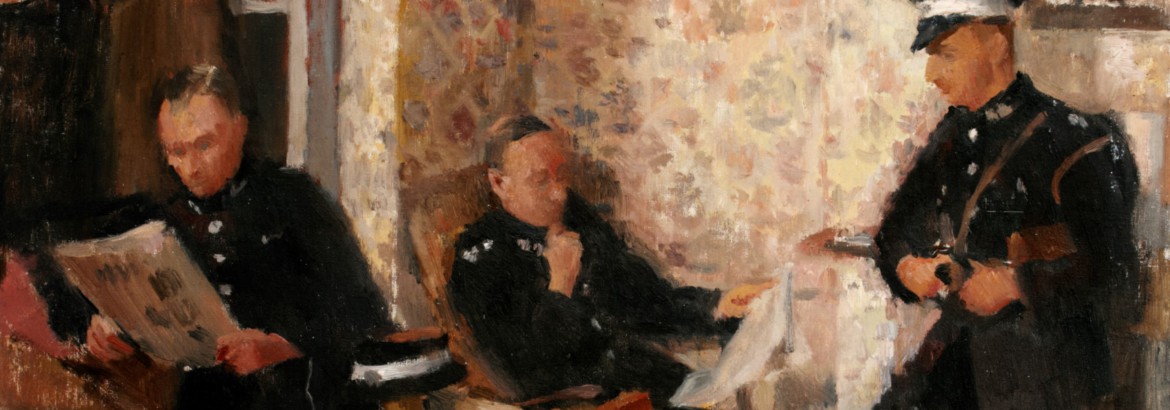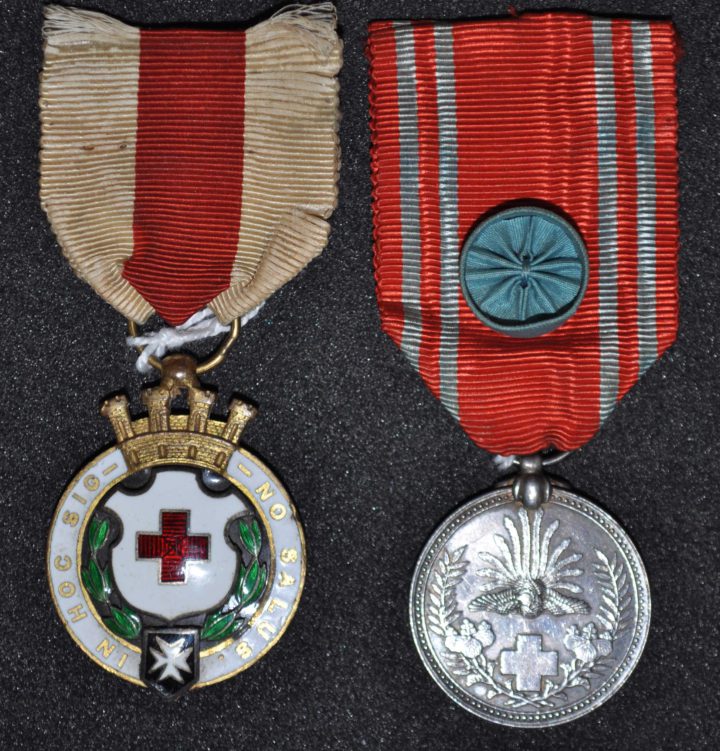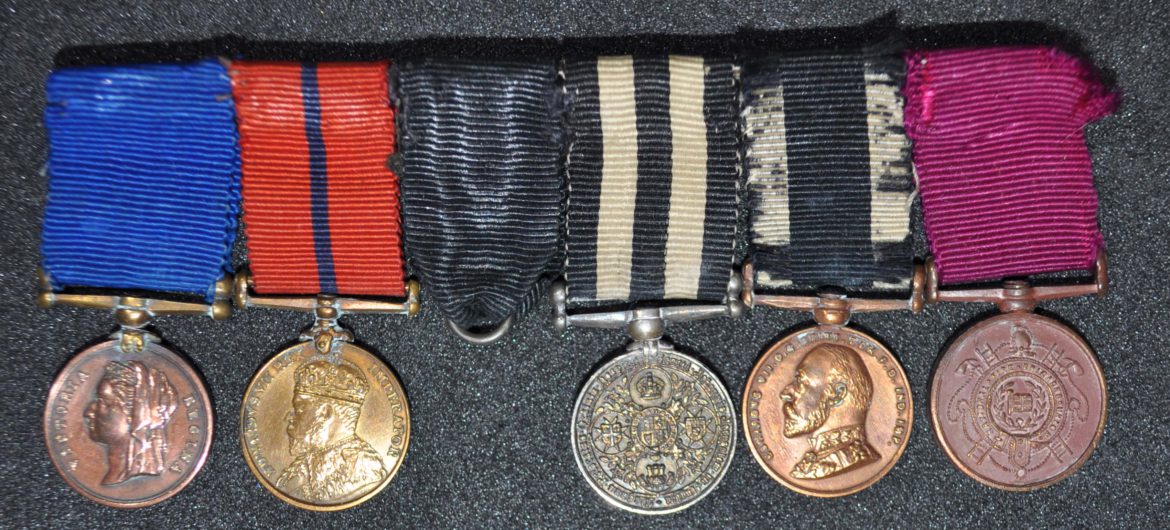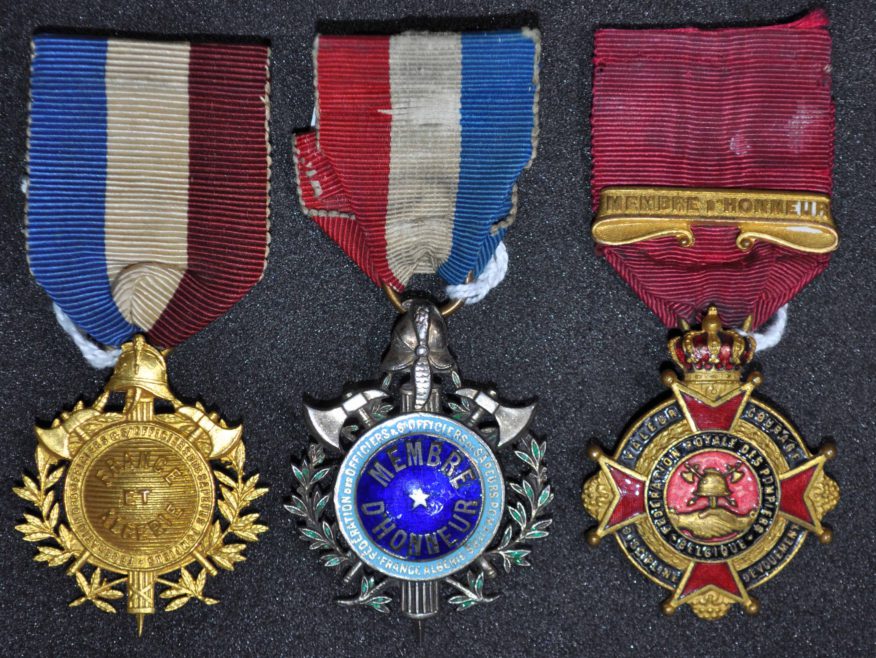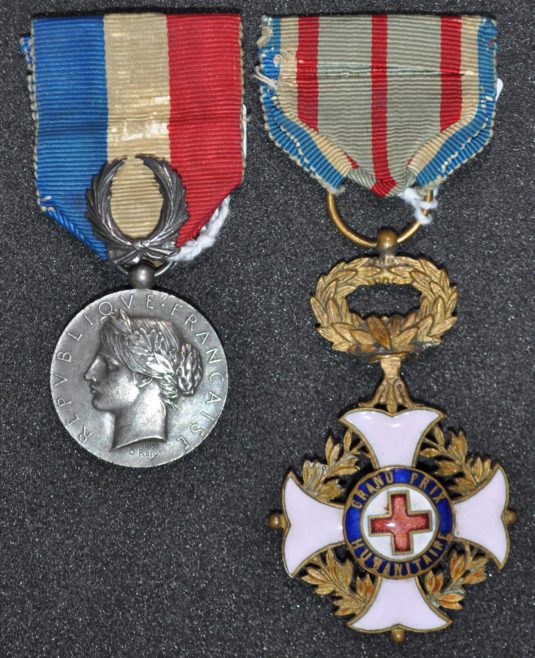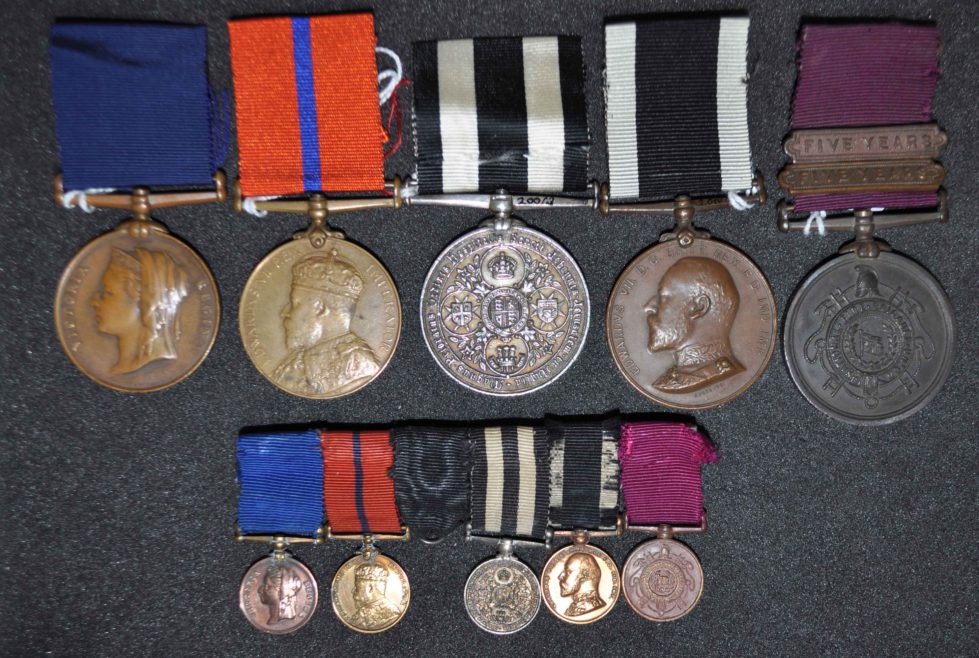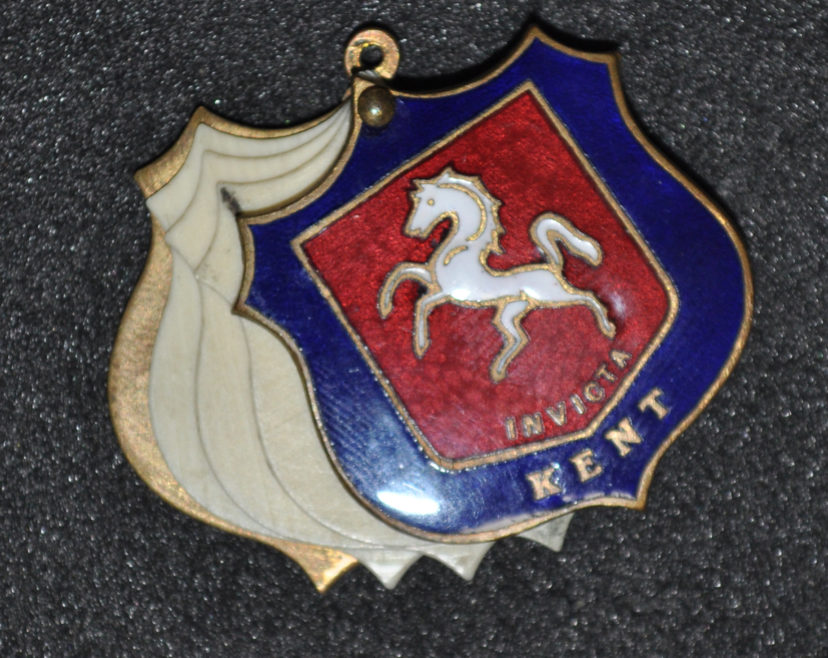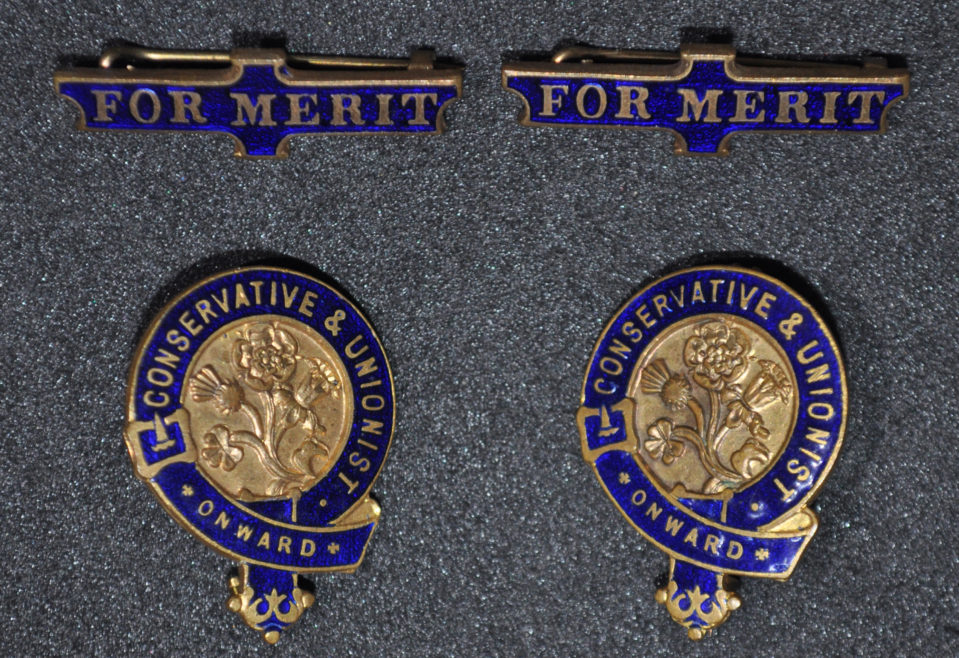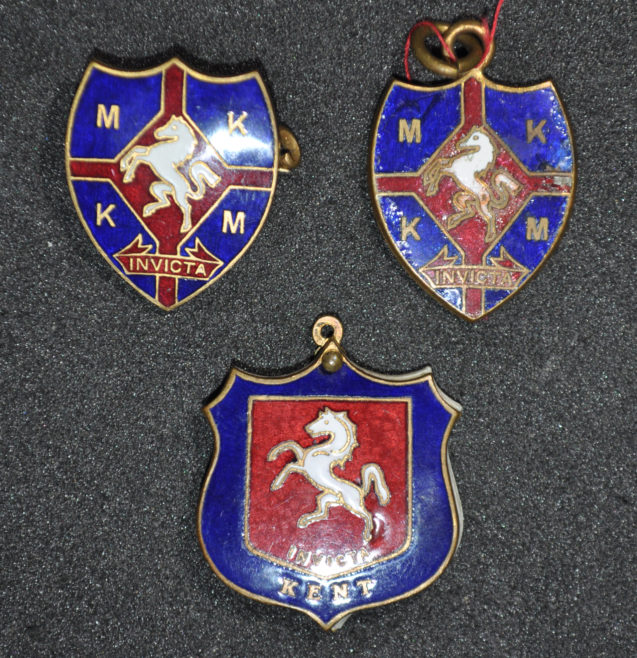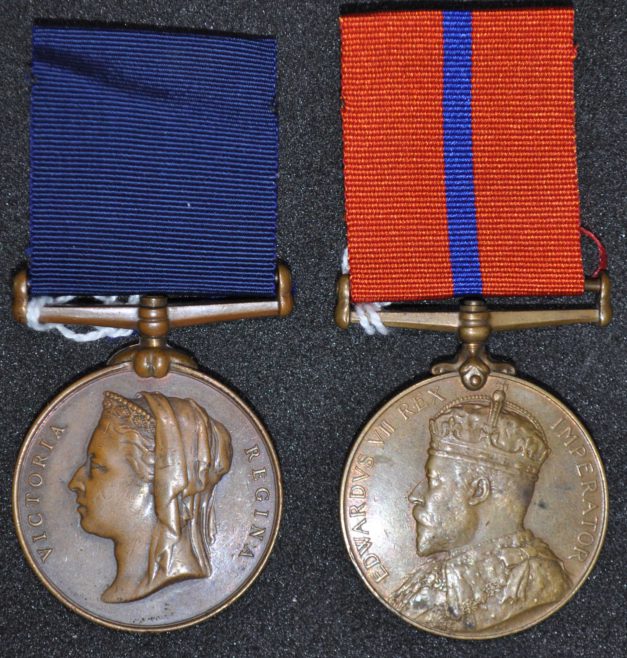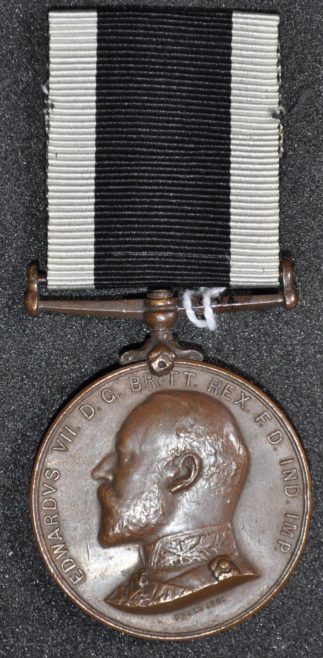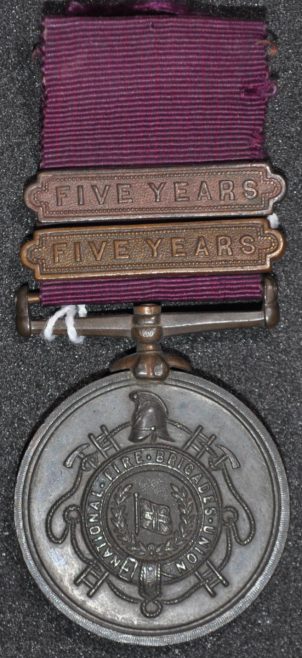Service Medal of the Order of St John
This is the Service Medal of the Order of St John awarded to Brigade Chief Superintendent W.J. Church Brasier in 1899. The design for this medal was approved by H.R.H. The Prince of Wales in 1898. Church Brasier was part of the first group to receive this medal when it was first introduced in 1899. It is engraved around the rim: No. 3 BRIGADE CHIEF SUPT. WILLIAM JOHN CHURCH BRASIER 1899. The engraving states the medal number, his rank and name, suggesting that this was probably the third service medal ever awarded. This medal represents 15 years of active and efficient service with the Order of St John (this was later reduced to 12 years in 1990). However, Church Brasier had over 20 years of service with St John Ambulance, but no additional 5-year bar on the ribbon. This is because the 5-year bar was only introduced on 28th November 1911, and Church Brasier died on 4th February 1911.

Medal of the Spanish Knights Hospitaller
This is the insignia of the Spanish Order of the Knights Hopsitaller awarded to Brigade Chief Superintendent W.J. Church Brasier. He also had the breast star as well as a miniature version. It has an accompanying certificate which states that it was awarded to Church Brasier on 8th June 1899, the certificate also states the full proper name of the Order as ‘The Supreme Council of the Hospitaller Knights of San Juan Bautista’.
The Order was originally created in 1802 during the secularisation of Spain under King Charles IV, however, their property was soon confiscated in 1820 during the Revolution. After the restoration of the royals in 1823 their property was returned, until 1841 when the Order’s property was once again confiscated. In 1848 the Spanish government auctioned off the Order’s property, and the Order was left a husk of its former self, demoted to simply the Royal Merit Order for services to Spain. By 1864 the Hospitallers were replaced in their active role by the Spanish Red Cross. But not all hope was lost, as with some help, in 1875 the active Spanish Hospitaller Order was revived, completely independent from Papal Order, with Chapters Cádiz, Madrid, Barcellona and Seville. They opened their first hospital in Madrid. In 1876 King Alfonso XII gave the Order some legitimacy by approving their statutes and rules and Pope Leo XIII granted the Order spiritual beneficies. But in 1885 the government once again recognised the Sovereign Military Order of Malta and their exclusive rights, including knights and royal merit, which devalued the status of the Hospitallers. Now lacking prestige and not fully recognised by the Crown, the Order eventually was reduced to one chapter in Cádiz. But, recently in 1952 the Cádiz chapter revised the statutes which were approved by the Spanish Ministry of Interior and Health and were reformed as the Knights Hospitaller of St John the Baptist of Cádiz.

Japanese and Spanish Red Cross Medals
Brigade Chief Superintendent W.J. Church Brasier received medals from both the Japanese and Spanish Red Cross Societies for his immense work with St John Ambulance. The Spanish Red Cross Medal was awarded to Church Brasier on 8th June 1899 and has an accompanying certificate. He also has the miniature version of the Spanish medal, but the Japanese medal does not have a miniature counterpart.
The Japanese Red Cross Society was founded in 1877 under the name “Hakuaiha” (The Great Charity Society). It was initially temporarily administering first aid during the Civil War but after the Civil War ended they became permanent, and in 1886 adopted the name Red Cross Society of Japan. They assisted during the Chino-Japanese War (1894-5) and Russo-Japanese War (1904-5) providing unrestricted first aid to both friend and foe. They also assisted during various natural disasters, including the volcanic eruption in 1888 in the district of Tywashiro and the earthquake in the district of Mino and Owari in 1891. They had several specially made hospital ships built and established a central hospital in 1886. The Society was supported with avid interest by the Emperor and Empress as well as the Crown Prince and Princess. The Princess was also involved in the Voluntary Society of Nurses of the Aristocracy which included many of the highest-ranking women in Japan, they looked after patients in relief stations, making bandages for them, visiting patients in hospitals, providing them with things to read and assisting some in writing letters home to their family.
There were three different classes, each with their own distinguishing medal: Honorary, Extraordinary and Ordinary. There was also an order of merit (Yukosho), this is medal which Church Brasier was awarded, the blue rosette attached to the ribbon indicates he was a life member.


Ordre de la Couronne d’Acier (Order of the Steel Crown)
This is one of the most mysterious medals in Church Brasier’s collection. We were initially unable to identify the medal – as we only had the miniature version it made it more difficult to see the designs and patterns. After much deliberation and fruitless searching through several medal books and on the internet, we then looked at the medal again under a magnifying glass and saw that the tiny writing might say the word ‘Patagonia’. So with new hope and more information we began the search again this time finally identifying the medal.
It is the medal of the Order of the Steel Crown, it is the medal with the bright green ribbon with red stripes, which in itself is strange as all other examples of this medal we found have red ribbons. This Order of the Steel Crown is the royal order from the Kingdom of Araunacia and Patagonia. This Kingdom has a relatively short, but interesting, history. It was originally founded in 1860 by Orelie-Antoine de Tounens, a French lawyer who claimed the land and was ‘voted’ in by the native Machupe people but was very quickly deported, declared insane and exiled back to France in 1862, where the royal house remained in exile for over a century. Orelie-Antoine died in 1878 and although the Kingdom no longer exists, some still claim to be its ruler up to the present day.
Exile did not stop Orelie-Antoine, as he founded the Royal Order of the South Star in 1869 but by 1872 was changed to the Royal Civil and Military Order of the Steel Crown, making it an order merit rather than a knighthood. It is unclear why Church Brasier has this medal, as far as we know Church Brasier has no connection with South America although perhaps they may have heard of him through their French connections.



